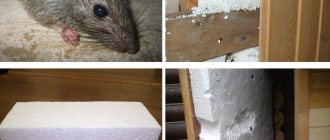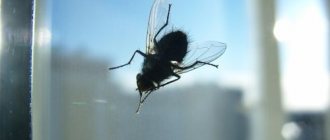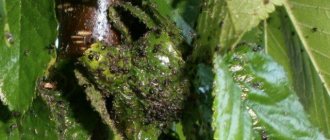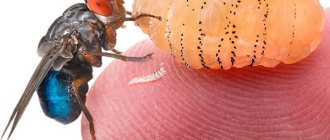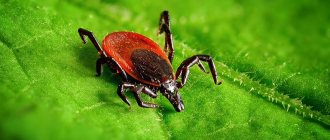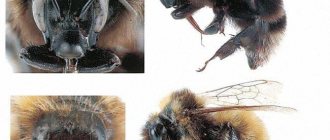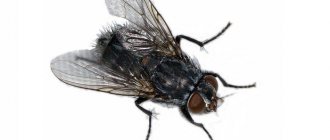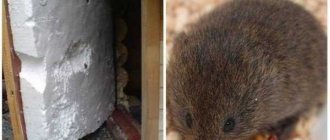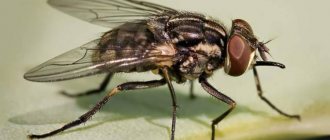During the warm season, dog owners notice that flies bite their pet's ears. Bites cause severe discomfort, pose a risk of wound infection and lead to serious consequences (sometimes life-threatening to the animal). Therefore, it is important to start treatment measures in a timely manner. What fly repellents should be used for animals can be found in this material.
The dog's ears are bitten by burner flies. They scrape the top layer of skin until blood appears. To prevent blood from clotting, flies produce toxic saliva, which causes severe irritation.
The animal scratches the bite site, resulting in wounds. The blood and the smell of the enzyme secreted by the ear glands attract harmful insects. Parasites literally begin to eat the skin in the ear and pinna area.
Predatory flies
Burner flies are one of the most common species of Diptera, closely associated with human habitation.
Most often, their clusters can be seen in a barn, poultry house, next to grazing cattle. They differ from the common fly in their food preferences. The main source of their vital energy is the blood of animals. Due to the proximity of yard dogs to the place where livestock is kept, they suffer no less from these unpleasant insects.
On a note!
Flies bite the most vulnerable places on the animal's body until they bleed - the nose, muzzle, ears. Most often, flies bite dogs' ears, since the hair in this area is very short and there is access to open areas of skin.
Diptera predators eat away at the skin, leaving behind open wounds. The dog cannot drive them away in time and is subjected to frequent bites. To save a faithful friend, owners must know how to treat their dog's ears against flies.
Causes of insect attacks
Houseflies, which accompany us throughout the spring and most of the summer, the most they can do to their “victim” is tickle them with their soft proboscis. It is not able to pierce tough skin. Such insects feed mainly on plant foods and waste products. Generally speaking, they do not pose a danger as such, and even more so they will not be able to bite a pet’s ear until it bleeds.
But when August arrives, a cool wind blows, and burner flies enter the fray. They are just very dangerous for animals. The basis of the diet of such insects is blood, so they live in pastures and farms. That's why they hunt animals: because pets cannot resist them. If flies eat a dog's ears or bite other animals, the owner tries in every possible way to help his pet, since the consequences can be unpredictable. Sadly, both male and female firebirds are bloodsuckers.
It must be remembered that zhigalkas can breed up to 4 times per season. Females lay their eggs, as expected, in compost and manure heaps. The heat from decay promotes the rapid development of larvae. After 5 days, the eggs hatch into young animals, which after (maximum) 8 weeks are able to breed new offspring. So it turns out that the dog is eaten by flies, of which by that time there are a lot. Therefore, you need to arm yourself with knowledge: what to do so that the animal does not suffer from these insects. When it starts to get colder, the zhigalki look for new habitats for wintering. That's why they become neighbors of people in a warm house.
It should be noted that the zhigalka is not picky about its habitat. It is found throughout the world, with the exception of the Far North. After all, at a temperature of -8ºС the insect dies. At the end of summer, insect predators expand their sphere of “influence” and fly into the house. Therefore, if your dog is eaten by flies, you need to immediately find out what to do to get rid of the scourge. After all, people who are unable to ward off biting insects also suffer from stink bugs.
What to do if an insect gets into your ear: first aid
Moths, midges, mosquitoes and flies can become a source of great trouble if they enter the human ear.
Hearing loss, the development of an inflammatory process inside the ear canal, and even perforation of the eardrum - all this can happen if the tiny insect is not removed from the ear in a timely manner.
We'll tell you what to do if a small insect gets into your ear, and how to avoid similar situations in the future.
What you definitely shouldn’t do if an insect gets into your ear
The main sign that an insect has entered the ear is the feeling of the presence of a foreign object in the hearing organ. Listen to yourself to see if a mosquito is buzzing in your ear. If the symptoms of the presence of an insect inside the ear are confirmed, you must not lose composure.
Rash actions can provoke a number of negative consequences, so it is important to get together and think through ways to remove a foreign body from the hearing organ. Experts do not recommend performing the following actions so as not to harm your own health
What not to do:
Experts do not recommend performing the following actions so as not to harm your own health. What not to do:
- Try to pull out an insect that has flown into the ear using a match, ear stick, knitting needle, tweezers and a number of other improvised objects. In this way, you can injure the ear canal or introduce an infection inside the organ, which will lead to consequences, even hearing loss.
- Try to drip alcohol, kerosene, and other liquids inside, which, according to folk craftsmen, can lead to the death of a mosquito. It is possible that the insect will actually die, but instilling a number of liquids into the ear can cause irreparable harm to human health and reduce hearing acuity.
The further the beetle moves inside the hearing organ due to inept human manipulation, the more difficult it will be to get it. The ideal solution in this case would be a timely visit to a doctor, who, using sterile medical instruments, will remove the foreign body from the hearing organ in a matter of minutes.
Insect removal methods
It is important for people who spend a lot of time outdoors, as well as parents of small children, to understand how to get an insect out of the ear without consequences. The easiest way is to move the ear for 3-4 minutes in a row, which can lead to the insect falling out of the ear.
https://www.youtube.com/watch?v=CQsqiRCCUS0
If the bugs in your ears are tiny, you can use water. It is instilled inside using a pipette, having previously been brought to room temperature.
Cold water can cause hypothermia and the development of otitis media
In this case, it is important to tilt your head slightly so that the midge can flow out of the ear along with the water.
You should not use ear sticks, otherwise the mosquito or fly will push even further into the ear.
https://www.youtube.com/watch?v=CQsqiRCCUS0
If this method does not help, you will have to go to the hospital, where a specialized specialist will remove the foreign body from the ear canal. You don’t need a special tool for this: usually a device for removing wax from a person’s ears helps solve the problem.
How to restore hearing after removing an insect from your ear
If self-removal of the insect is successful, it is important to take a number of measures to restore the integrity of the skin of the auricle and ear canal and prevent the risk of infection getting inside the ear. First aid if an insect gets into your ear is as follows:
First aid if an insect gets into your ear is as follows:
- The ear is lubricated with an alcohol solution, which is dripped onto a cotton swab. Such measures make it possible to eliminate an infection or inflammatory process caused by damage to the skin by the paws of the beetle itself or by a tool for removing it.
- If swelling, redness or other allergic reactions occur from a bee sting in the area inside the hearing organ, you should take an antihistamine. It will help relieve swelling and reduce pain.
Important! The sick person is advised to take a horizontal position for a while after removing the fly from the ear, in order to avoid an accident due to loss of coordination.
Conclusion
Situations where insects crawl or fly into the ear are not uncommon. Moreover, the negative consequences of such a nuisance are in most cases exaggerated. Indeed, bugs or mosquitoes crawling into the ear can cause hearing loss.
But knowledge of how to properly remove a mosquito from the ear allows you to reduce to zero the risks of developing an inflammatory process inside the hearing organ and maintain the acuity of perception of the outside world through sounds.
The danger of firebug bites
Zhigalkas are predators, so their mouth proboscis is capable of biting through the ear of a pet, after which a whole flock will begin to feed on this animal. In a very short period of time, insects bite through the skin until it bleeds, and now the owner is faced with the question: what to do to save the pet.
When flies eat a dog until it bleeds, the insect first rubs the victim’s skin with its proboscis, thereby scraping off the epidermis. Well, then it’s a matter of technology. Dinner is served and the dog is eaten by flies until serious wounds appear. Of course, the owner can notice the process much earlier and take serious measures. During a bite, a poisonous secretion is injected into the animal's blood, leading to skin irritation. The poisonous secretion helps prevent the blood from clotting, which means the zhigalka has something to eat. In some cases, when flies eat a dog’s ears, you need to know how to treat it, because an allergic reaction may occur. Together, this can lead to high fever and nausea. This is why the process of “eating” is so painful for the animal.
In addition, zhigalkas carry infectious diseases, among which the most dangerous are:
- anthrax;
- staphylococcal infection;
- sepsis;
- tularemia.
Some of these diseases are zoonotic. This means that they are equally dangerous for both animals and humans. Why do flies and other biting insects become more active in the fall? What to do to prevent infection?
There is an opinion that insects begin their aggressive activity because they sense their death. This statement is fundamentally false. They bite the ear and other parts of the animal's body until it bleeds in order to obtain a daily diet that promotes procreation.
Algorithm of urgent actions
Experienced dog breeders know what to do if a dog is bitten by a midge.
Cooling swelling from a dog insect bite
- First of all, you need to determine whether there was a bite? If you see a dog that scratches its muzzle, whines, chews its paws, or has rapidly increasing swelling in any part of its body, we can conclude that it has been bitten.
- Then you need to try to determine which insect might have bitten the dog. Sometimes it's enough just to look around.
- It is necessary to soothe the bite site. For example, you can apply a thick mixture of baking soda and water to the bite.
- Ice should be applied to the affected area for about ten minutes to minimize swelling. Ice can be replaced with a damp, cold towel.
- An allergic reaction in dogs must be stopped immediately. To do this, the pet needs to be given a small dose of an antihistamine. It is best to ask your veterinarian about the appropriate dosage of the medication.
- A cone collar will save the dog from further injury to the affected area. And this, in turn, will significantly speed up healing and reduce the risk of contracting infectious diseases.
- The pet must receive sufficient fresh water and food.
There are cases of severe allergic reactions after midge bites. The occurrence of certain symptoms should be of particular concern. Immediate veterinary care is required if the pet's breathing becomes difficult and shortness of breath appears; there is copious secretion of saliva; the animal is overly excited; diarrhea or vomiting appeared; disorientation in space, as well as convulsions.
A dog that has been bitten by a midge may need medications from different groups:
Remedy for itching in dogs
- Cardiac drugs (for example, cordiamine).
- Antihistamines that need to be given as intramuscular injections or given in tablet form - suprastin, tavegil, diphenhydramine.
- Diuretic injections – Lasix and others.
- Ointments that soothe itching - lorinden for midge attacks, dermazin or celestoderm. Tetracycline ointment is used for the eyes.
The dosage of all medications depends on the size of the pets.
This is how even a small midge can threaten the lives of pets. Drug treatment helps to minimize allergic manifestations and shock in the animal. Sometimes there is a need to hospitalize the dog and connect it to an IV. Doctors may take blood and urine tests. Treatment in a hospital setting can take two days or more.
How can you tell if your dog needs help?
If a dog lives outside, a swarm of flies circles around it. Flies are capable of laying eggs on animals. This leads to the appearance of maggots that eat the pet alive.
You can determine if your pet is being bitten by flies by the following signs:
- there are wounds on the skin, and dried blood around them;
- the animal refuses food and water, as a result of which it loses weight;
- Hair falls out at the site of the bite.
Sometimes the above symptoms are accompanied by fever and vomiting. In this case, the pet needs to be taken to the vet immediately.
Preventive measures
To protect your pet from fly bites, it is recommended to follow the following preventive measures:
- If the dog lives on the street, the enclosure is kept clean. After each meal, wash the bowl thoroughly.
- Special fly traps are installed near the booth. Adhesive tape is placed on the ceiling of the enclosure.
- Not far from the enclosure, fresh yarrow, wormwood, tansy, and celandine are laid out.
- Clean your ears regularly. This is done with the help of hygiene lotions, napkins or powder. Do not use hydrogen peroxide or vinegar for cleaning as this will cause severe burns.
- The ears are treated with Mukhotsid spray. Before using the spray, the dog is not bathed for three days.
- The ears are lubricated with essential oil of clove and lavender. Harmful insects cannot tolerate this smell.
Regular preventative measures are much cheaper than treating the animal.
What places do flies bite most often?
Flies can bite pets on all areas of the body, but the ears are the most affected. Flies are attracted by the smell that is formed when a special enzyme is released.
Some dog breeders believe that enzyme production can be reduced by ear cropping. In their opinion, after such an operation, insects stop attacking animals. However, this statement has no evidence, is not supported by scientific research and does not correspond to reality. Flies do not ignore dogs with cropped ears.
Why are flies dangerous for dogs?
Burner fly
Dogs are attacked not by ordinary houseflies, but by another type of insect - the burner fly. These parasites are very similar in external structure to the flies that we are used to seeing in the apartment. The length of the body of the burner is about 6–7 mm. The main color of the insect is gray, dark spots can be seen on the abdomen, and stripes on the chest. However, the distinctive feature of a predatory fly is the structure of its mouthparts.
In the zhigalka, this organ has the shape of a long proboscis, at the tip of which there are curved chitinous plates. They help the fly remove the top layer from the surface of the victim’s skin and reach the capillaries. Livers feed on the blood of dogs. When attacking, they release poison that greatly irritates the skin of pets. When bitten, the animal experiences pain.
Irritated and damaged skin is a favorable environment for the proliferation of pathogenic bacteria. In addition, zhigalki are carriers of pathogens of many diseases, such as staphylococcus. Your pet can become infected with anthrax and tularemia. Once in the bloodstream, the infection spreads throughout the body and affects all organs. Some diseases are transmitted to their owners from dogs.
First aid for bites
If flies have bitten your dog's ears, first of all, do the following:
- Wounds are thoroughly washed with water and antibacterial soap.
- The bite site is wiped with an antiseptic (Chlorhexedine, hydrogen peroxide).
- If the wounds are wet, they are cauterized with brilliant green, iodine or Fukortsin (they have drying properties).
- The wound is lubricated with Levomekol ointment. The product has an antimicrobial effect, which makes the healing process faster.
- Antihistamines are used to relieve itching. Drugs intended for humans (Suprastin, Tavegil, Diazolin) are suitable for this purpose, but the dosage should be discussed with a veterinarian.
- If the affected area is large, sedatives are used to reduce pain and itching.
After performing the above-described manipulations, the pet is put on a protective collar to prevent it from licking or scratching the wounds. It is also recommended to use puffs - special covers that protect the auricle from mechanical damage.
How to eliminate medium and large hematomas?
Large tumors cannot be dealt with using the methods presented above. They will only aggravate the pet’s condition and can provoke the formation of suppuration. If your dog has a large hematoma full of fluid in his ear, he may need to have the blood drained with a syringe or have surgery. This treatment is carried out in a clinic. It is started 3-4 days after the hematoma appears, when the flow of blood into the cavity has already been completed and a blood clot has formed in it.
Pumping out with a syringe
For extensive uncomplicated injuries, the doctor may do without surgery. He will eliminate the hematoma with a syringe. This manipulation is carried out like this:
- The dog is fixed so that during the procedure he does not jerk his head (this will lead to injury to the affected ear). Anesthesia is not used for this treatment.
- The skin around the hematoma is treated with antiseptics.
- A puncture is made in the upper edge of the ear, through which the blood is sucked out. They try to eliminate the liquid without any residue, but if a small amount remains, it will resolve later.
- The syringe is changed, leaving the game in the wound. A solution of novocaine and antibiotics is injected into the cavity. Their type, as well as the dosage, are selected depending on the condition of the pet, the presence of complications, and the threat of pus.
- The ear is bandaged. The pet is given a hard collar to prevent it from scratching the damaged area.
Pumping out fluid from the cavity can be carried out in several sessions. Usually there are 5-7 of them. This is due to the fact that after the first treatment, blood soon begins to collect in the wound again. If the hematoma does not go away after such manipulation, surgical treatment is prescribed instead.
Carrying out the operation
Surgical intervention is prescribed in the most severe cases, when conservative methods do not give the desired effect. Do it like this:
- The dog is given general anesthesia. This is necessary so that the animal does not move its head during the operation.
- The affected ear is prepared for opening. The fur is shaved off and treated with chlorhexidine or another antiseptic. This is necessary to prevent infection from entering the wound.
- An incision is made along the ear. Remove accumulated liquid. If necessary, secure the damaged vessel with a ligature.
- The cavity is treated with an antiseptic.
- The ear is stitched. For this purpose, a rolled seam or through stitching of fabrics is used. The latter causes adhesive inflammation, allowing the cartilage and skin to grow together. If purulent processes are observed in the cavity, it is not sutured. The dog in the presented case may be left in the hospital for several days to ensure proper conditions of detention and regular treatment of damaged tissues. The wound will be stitched up only after pus stops accumulating in it. Partial suturing of the ear is performed if the vessel cannot be completely restored and the risk of re-hemorrhage remains.
After carrying out the presented manipulation, a collar is put on the dog so that it does not injure the damaged area of the skin. The animal is prescribed bandages, treatment of the ear with special antiseptic ointments and means to avoid scarring. In the future, the dog breeder will need to treat the dog at home.
The above version of the operation is used for venous, arterial or mixed type of hematoma. Such injuries require surgical treatment 4-5 days after the appearance of the tumor. For a pulsating type of pathology, surgery is prescribed on the first day, without waiting for a blood clot to form. Do it like this:
- give the animal general anesthesia;
- cut open the damaged ear, find the bleeding vessel and sew it up;
- remove residual blood from the wound and treat the tissue with an antiseptic, then the incision is sutured.
In most cases, the operation is successful and allows you to cure a hematoma even if a large vessel is damaged. But the veterinarian is not always able to restore the shape of the ear, especially if it was severely injured or the dog owner was late in seeking help for the pet.
Video: hematoma of the ear and auricle in dogs, its treatment and ear care
Treatment of bites and swelling
If, nevertheless, flies have bitten your ears, it is necessary to take measures to eliminate the itching and relieve swelling. You should not allow your pet to tear the bites into wounds. Any inflammation or wound in the ears should be washed with clean water using a cotton swab and treated with chlorhexidine. Cover the wounds with brilliant green. To prevent your dog from itching, you can give a tablet of Suprastin or Tavegil. Antihistamines will relieve swelling and inflammation if the dog is in pain and wants to tear its ear.
Pets look quite funny in clothes, but in the case of flies and mosquitoes, this is the only way to protect the dog in the evening in nature, when there are a lot of insects. Hats for dogs, purchased at specialized pet stores, will help hide the ears from blood-sucking flies and mosquitoes, and will protect them from the dog itself if it decides to scratch the wounds that have already appeared from bites.
Diagnostics
If there are a large number of flies flying around your area, take a closer look at the dog. You may see that insects are constantly circling over him, the tips of his ears are bleeding, the wounds are inflamed and literally covered with parasites. In the most advanced cases, you can even see tiny worms in the wounds - these are larvae that hatched from eggs laid by non-insects.
Most often these are burner flies. Their active period occurs at the end of summer and beginning of autumn. They are real bloodsuckers. Gnawing through the skin of a dog's ear and feeling the first drop of blood, the number of flies attacking the animal becomes alarming.
A dog cannot drive away insects on its own. Your pet will begin to worry, hide, and refuse food when its ears are already significantly damaged and inflammation begins. To prevent this, you need to think in advance - how to treat your dog’s ears?
How to protect your pet from such a problem?
It is easier to take preventative measures than to try to remove ear mites from your pet. Helpful Tips:
Parasites can easily be contracted from a sick animal. When walking, it is better not to allow your dog to interact with stray animals, even if they look healthy. This is the most effective method to help prevent disease. Inspect your pet periodically to identify ticks in time.
You need to pay attention to your ears; if there is a lot of wax in them, this indicates otodectosis. Then you need to treat them with cotton swabs. Use insecticides
They will be useful after successful treatment to prevent relapse. You can use drops, sprays, shampoo, lotions. You need to carefully choose the drug, taking into account the characteristics of the animal and contraindications.
To prevent a relapse, you should thoroughly clean your house. It is worth boiling all your pet’s fabric things (clothes, toys, bedding). General cleaning and disinfection should be done twice a week.
During therapy, the pet should not touch the bedding. You should also ventilate the room more often. In winter, it is worth freezing furniture and carpets. For a successful and quick recovery, it is necessary to begin treatment immediately and contact a veterinarian at the first sign.
How to treat fly bites
If fly bites could not be avoided and as a result, wounds have formed on the dog’s ears, then in order to cure them, it is necessary to wash the affected areas of the skin with Chlorhexidine. After which they should be regularly smeared with Levomekol. The juice of plantain, wormwood, bird cherry, wild rowan or tansy also contributes to speedy healing.
If flies begin to bite your dog's ears, you must immediately help your pet using any of the above remedies. Otherwise, the wounds will begin to become inflamed, causing pain and suffering to the pet.
Treatment of affected areas of the ears
In the event that the cartilage is significantly damaged and the inflammatory process has begun, you should immediately begin treatment measures. First you need to treat the affected area with a special antiseptic and show your pet to a veterinarian. Very often, specialists prescribe antibacterial drugs to eliminate inflammation. The most important thing is to protect the place where the dog stays from flies.
Thus, antibiotics will help eliminate inflammation and prevent blood poisoning of the animal. The history of veterinary medicine knows cases when a pet had to have a third of its ear removed because it was simply impossible to restore its integrity. The owner’s most basic actions should be aimed at not waiting for flies to attack, but at carrying out special treatment of the dog and his enclosure.
Insect repellent spray for dogs
Sprayers are a fairly convenient type of insect repellent for animals. Ease of use allows the owner to take the bottle or bottle with him and use it if necessary. Easily applied to the surface of the coat, ears, face. In this case, the eyes should be protected from direct contact with liquid, which is quite irritating to the mucous membrane, and from the presence of essential oils in it. Otherwise, the product is safe for animals and humans.
The spray contains various fillers from essential oils of plants - eucalyptus, chamomile, clove, lavender, which insects do not like because of their strong odor. The smell of the dog becomes less pronounced. The substances do not accumulate in the animal’s body and do not harm it, covering only the surface of the fur. They are environmentally friendly for nature and do not harm humans.
Methods for controlling raspberry flies
Pest control should begin in early spring to avoid mass flight of insects and, accordingly, the laying of larvae on the leaves. Traditional methods can be used as preventive measures or in the initial stages of their detection. If it comes to finding larvae in the stems, you won’t be able to do without insecticides.
General sequence of actions to protect raspberries:
Early spring, after the snow melts: dig up and loosen the soil well under the bushes. You can scatter ground pepper, ash, and dry mustard over the area to create an aggressive environment in the soil, which will contribute to the destruction of the shell of the pupae and their subsequent death. The main thing is not to use salt, since it contains chlorine, which is harmful to raspberries.
Mid-late spring (period of mass emergence of adults): treat with insecticides
When choosing a drug, it is important to consider its possible toxicity to pollinating insects).
- The phase of active growth of young shoots and budding: watch the bushes in time to notice the first signs of the appearance of raspberry fly larvae, cut and burn damaged stems. When removing the affected area, you need to grab a little healthy part of the plant. Cutting at the root is not necessary.
- Autumn, after harvesting: re-dig the soil, if necessary, repeat treatment with insecticides. You can additionally shed the soil with Bordeaux mixture.
Insecticides
If there is significant damage to the bushes, it is necessary to spray with chemical or biological insecticides. The procedure is carried out in calm, dry weather in the morning or evening to prevent the foliage from being burned by the sun's rays. The working solution can be prepared using the following products:
- Agravertine. A biological product based on soil fungi that is not addictive to pests. It shows maximum effectiveness in hot weather; when it cools down to +18°C, the result will be less pronounced.
- Actellik. A complex preparation with a gastrointestinal effect, suitable for treatments at air temperatures up to +25°C. Due to high toxicity, use no more than 2 times per season is allowed (necessarily before flowering begins).
- Spark. It has a wide spectrum of action, including effectiveness against raspberry flies. 1 tablet is enough to prepare 10 liters of solution.
- Karbofos. Enteric contact insecticide. Can only be used for processing in the autumn after harvesting, preferably at a temperature not lower than +15°C. Not suitable for flowering period.
- Confidor. Contact low-toxic insecticide, characterized by resistance to washing off and good effectiveness even in hot weather. Available in the form of powder, suspension or ready-made solution.
- Fitoverm. A biological preparation that does not have a toxic effect on bees and is also suitable for summer treatments, but no later than 2 days before harvest.
When using chemicals, it is important to follow the dosages indicated in the accompanying instructions and do not forget to use personal protective equipment when spraying plants
Folk remedies
The following can help in the fight against stem fly:
- Mustard solution: dissolve 150-200 g of mustard powder in 10 liters of warm water.
- Tansy decoction (during budding): boil 250 g of dry herb in 2 liters of water, then increase the volume of liquid to 5 liters.
- Garlic infusion: infuse a mixture of 200 g of crushed cloves and 3 liters of warm water in a warm place for 3 days.
- Soda solution (for the period of setting berries): stir 3 tbsp. l. soda per 10 liters of water.
To improve the adhesion of solutions to the surface of leaves and stems, you need to add crushed laundry soap.
Insect traps
An additional measure to combat raspberry flies can be the use of traps for garden pests, sold in stores for summer residents:
- garden adhesive tape;
- “Evil TED”, etc.
You can also make a trap yourself from a plastic bottle by cutting out 3-4 windows in it. The jumpers between them must be wide enough to maintain the strength of the structure. The bottles are hung (for example, on trellises) among the raspberry trees, and syrup, juice, beer or other sugar-containing liquid is poured inside. Even if it ferments, the increasing sweet smell will attract insects even more.
Good to know: What causes raspberries and how to cure them
Folk insect repellents for dogs
Ordinary products from the human table can serve as a substitute for various bottled products. For example, vinegar. Many owners treat their pet’s ears with a weak solution of vinegar and water. Carefully soak the cotton wool with the solution and wipe the ears, leaving an unpleasant odor for flies. Vinegar also repels other insects, but you should not smear it on open wounds if you already have bites.
Live collections of chamomile, lavender or cloves are also suitable for lubricating the ears. Chamomile is also an excellent antiseptic. It can be used to treat wounds and bites. The collection can easily be replaced with a drop of lavender or eucalyptus essential oil diluted in water. You need to carefully ensure that water does not flow into the ear canals, this can cause otitis in the dog and irritation.
Cough remedies containing eucalyptus, which repel flies and mosquitoes, are often discussed on forums. But when choosing this remedy, the owner must understand that all syrups contain sugar, which can also provoke an invasion of flies and mosquitoes, profit from it, which will make it even worse. Therefore, oils are more effective.
Tar soap is used to repel insects. Its strong, foul odor can repel more than just flies. In an apartment, such a smell can become unbearable for the owners themselves. Mixing the smell of dog and tar, it is not difficult to imagine what the air around will be like. This product is best used for kennel dogs, outdoors.
Fighting dirt in the ears
The main rule for caring for your pet’s ears to prevent flies from biting them is to regularly clean them for your pet . Flies often flock to the dirt in the ears when the smell of sulfur is heard. Regardless of bathing or where the pet lives, the animal’s ears should always be clean and dry. To do this, you can use ear sticks dipped in water or a piece of cotton wool. Water can be diluted with sea salt, this cleans well and kills germs, and the salt repels flies. You can use a special lotion to clean your ears. The lotion is dripped into the ear canal and they begin to massage the ear. The dirt quickly moves away from the walls, and its remains need to be wiped with a swab, pulling it out.
Scaring methods. Chemical
Of course, the first thing that comes to mind if flies eat away at a dog’s ears is to use various chemicals. There are many insecticides and repellents for flying insects, but the effectiveness of each will have to be tested on each individual dog. The fact is that not all products last equally long on the skin.
Aerosols and sprays are quite toxic and using them several times every day is dangerous for the animal. This can cause poisoning, digestive disorders, and vomiting.
Products in the form of repellent pencils are somewhat gentle, but also have a short period of action. Putting chemicals on your dog's ears is not enough. It is necessary that it be “long-lasting” and relatively safe. And such means exist.
Article information
This article was co-authored by. Dr. Elliott, BVMS, MRCVS is a veterinarian with over 30 years of experience in veterinary surgery and the care of companion animals. She graduated from the University of Glasgow in 1987 with a degree in Veterinary Medicine and Surgery. He has been working at the same animal clinic in his hometown for over 20 years.
Category: Dog Health
In other languages:
English: Keep Flies Off Dogs, Português: Manter as Moscas Longe do Cachorro, Español: mantener a las moscas alejadas de tu perro, Français: garder les mouches loin de son chien, Deutsch: Fliegen von Hunden fernhalten, Italiano: Tenere le Mosche Lontane dai Cani, العربية: إبعاد الحشرات عن الكلاب, Nederlands: Vliegen van honden af houden, 日本語: 犬にハエを寄せ付けない, 中文: 让苍蝇远离宠物狗
This page has been viewed 2783 times.
Was this article helpful?
Not really
Plant decoctions
If flies circle over the dog and try to “occupy” its ears, you need to treat them with a strong decoction of bay leaves. Pour a pack or two of “lavrushkas” with a liter of boiling water, cover with a lid and let it brew. When the broth has cooled, thoroughly moisten the gauze and “wet” the dog’s ears as thoroughly as possible. Make sure that the broth does not get inside the ear. The taste of this solution is very bitter, and the smell is very effective in repelling flies.
A decoction of wormwood has a similar effect, and in addition, an excellent remedy would be to hang bunches of wormwood in the enclosure or even “push” it into all the cracks of the booth. You can practically caulk the booth with dry wormwood. The main thing is that you can smear with such decoctions as often as necessary.
Contactless means
Some pets live in enclosures. They are more susceptible to flies than others. Constant use of chemicals can have a negative impact on the animal. Therefore, it is recommended to use contactless means.
Devices may have plastic or metal boxes that can be replaced. The non-contact product operates at a distance of several meters, so it can be installed at some distance from the enclosure or dog house. Such devices are safe for people and all types of animals. They only affect insects.
Tar
An excellent fly-repellent product is birch tar. It is not difficult to find it in its pure form; it is available in many pharmacies. You can anoint your dog's ears with tar without any consequences for him.
Its smell is very unpleasant, but you have to put up with it, since its benefits are undeniable. You can treat your dog with an ointment containing tar, but first study the instructions. It is not recommended to use various tar ointments containing hormones for preventive purposes.
Salidol
This may seem unnatural to some, but dog breeders often use salidol as a fly repellent. The eerie smell will probably scare away not only flies but also people, but it's worth it. Salidol contains fatty acids from vegetable oils.
The dog will also find this aroma unpleasant, but most likely it will get used to it. Make sure that the animal does not shake off or smear this lubricant on foreign objects - it is very difficult to clean off.
How to protect dogs from ear flies?
At different times of the year, our pets are susceptible to various seasonal diseases. In the cold season, chronic diseases and colds worsen. In the warm season, a new scourge is added to injuries and somatic diseases - insects.
Fleas, ticks, flies, gadflies and other representatives of the insect world, causing both animals and owners a lot of concern. Flea dermatitis, babesiosis, Lyme disease - the list of diseases transmitted by insects is endless.
Owners of enclosure dogs often have to deal with such an unpleasant phenomenon as injury to the animal’s ears by insects, in particular burn flies. Insects literally gnaw at the pinna of the ear, causing serious discomfort to the animals. In addition, there is a huge possibility of a secondary bacterial infection, not to mention the neuroticization of the animal.
The dog is nervous, constantly tries to scratch its itchy ears, and loses its appetite. When the problem is advanced, the general condition of the animal worsens, and when secondary microflora is added, it becomes very threatening to the dog’s health.
Let's look at how you can deal with this problem, and what proven veterinary medications and products for dogs are best to buy.
Preventive actions
Let's start with organizing places for keeping animals. Regular cleaning of enclosures and walking areas, followed by disposal and chemical treatment of waste, disrupts the life cycle of insects.
Burner flies, which feed on the blood of warm-blooded animals, after feeding three times a day, lay from 20 to 100 eggs in animal feces or rotting plant remains.
Cleaning up faeces every day, storing them in a specific place and treating them with even inexpensive disinfectants will prevent the appearance of a new generation of flies.
After feeding, no food residues should remain in the container. Anything that falls out of the bowl while the animal is eating should be removed so as not to attract insects.
Enclosures should be regularly treated with disinfectants and insecticides. In addition, it is desirable to have insect traps and additional treatment with repellent preparations.
Animals must also be treated against insects with insectoacaricidal preparations.
Such an integrated approach will ensure a high probability of preventing attacks by blood-sucking insects.
How to protect animals from attacks by blood-sucking insects
Mechanical protection involves creating a barrier that is insurmountable for insects. This method includes:
- lightweight covers - puffs that protect the ears of animals. They can be worn both for preventive purposes and during the treatment process, as protection for damaged ears, in order to avoid abrasion of applied medications or re-injury or infection.
- Coating the ears with substances that prevent insect attacks. In addition to the purely mechanical barrier that a thick layer of grease forms, for example, some substances have a pungent odor and can repel flies. These include tar, Vishnevsky ointment, Yam ointment, creolin, kubatol. The downside of these substances is the pungent odor and the need for frequent application. In addition, dogs often wear off such protection on the enclosure or simply with their paws.
Separately, we can distinguish substances that have a pronounced odor, but do not mechanically protect the ears. These include clove oil, a mixture of aromatic citrus oils, Gardex Extreme aerosol, OFF cream for flies and horseflies, Mukhicide.
They have more of a repellent (scaring) effect. A special feature of the application is the frequent application of drugs and a peculiar smell.
We should not forget about individual intolerance to both odors and the substances themselves in animals and their owners.
Often, experienced dog breeders use drugs used in animal husbandry. It must be borne in mind that they are designed for fairly large animals, so the dosage and frequency of use must be carefully calculated depending on the size and weight of the dog. These include Bayofly Pour-on from.
Typically, the drug is applied once every 28 days. After using the drug, a repellent and insecticidal effect is achieved. To protect the animal as a whole, the drug is applied pointwise along the spine. To protect the ears, the drug is applied to the outer side of the auricle in an amount of 0.2 - 0.3 ml for each ear.
In this case, the individual hypersensitivity of the animal to the components of the drug is taken into account.
What to do if flies gnawed your dog's ears
It is necessary to treat the affected areas of the auricle: rinse carefully with a disinfectant solution, avoiding contact with the eyes. Soak, remove the crusts, apply wound healing agents.
Wear a protective collar or puff-cover to protect the ears from mechanical damage by the animal itself and repeated attacks by insects. Depending on the degree of damage to the animal’s ears, general treatment is prescribed—injectable antimicrobial, anti-inflammatory, and wound-healing drugs.
Additional treatment of the animal and enclosure with repellents and installation of insect traps are required.
To summarize the article, we can say that preventive measures, methodically and regularly applied to combat blood-sucking insects, are much cheaper than eliminating emerging problems. Properly organized places for keeping animals and a set of sanitary and hygienic measures aimed at maintaining cleanliness and order relieve animal owners from many problems.
Ear diseases in dogs.
There are not so many causes of ear diseases in dogs, so let’s look at each of them:
- allergic reaction to food (the pet’s food was changed, or the dog “stole” something from the table, or picked up some piece of food on the street);
- water getting into the ear;
- sulfur accumulation;
- parasites (mites), bacteria, fungus;
- injuries. Even while playing with other dogs, your pet can injure the ear.
- predisposition to ear infections.
According to statistics, the most susceptible to ear diseases are dog breeds with long, floppy ears. And there are plenty of reasons for this: dogs “sweep” the floor and the ground with their long ears, the ears are not ventilated, and if water gets into the ear, the owner cannot immediately notice and wipe off the moisture, like in pets with erect ears.
Now, let's look at the symptoms of major ear diseases in dogs.
The first signs of an auricular hematoma are an increase in the size of the ear and the appearance of a swelling on the inside or outside of the auricle. The pet behaves restlessly and shakes its head for no reason. If the hematoma is infected, then traces of suppuration are visible at the site of the swelling.
A common disease in dogs is inflammation of the outer ear (otitis), which affects not only the skin of the auricle, but also the external auditory canal. Inflammation of the outer ear tends to occur in both acute and chronic forms. The causes of this particular disease can be all of the above, and even a breed predisposition.
When the outer ear is inflamed, the four-legged pet begins to rub the sore ear with its paws and shake its head. The general condition of the animal worsens, the dog is either restless or depressed. Possible refusal of food.
If you lightly press on the sore ear, you will hear a characteristic squelching sound and you may see a dark brown liquid with an unpleasant odor in the ear canal.
Inflammation of the middle and inner ear in dogs means that an infection (hemolytic streptococci or staphylococci) is present. Inflammation begins with problems of the middle ear, and then progresses to inflammation of the inner ear.
Moreover, the disease is often complicated by suppuration. In most cases, smooth-haired dogs are susceptible to these diseases. The purulent form of the inflammatory process is accompanied by an increase in body temperature, discharge of pus from the ear, vomiting, and loss of appetite. The disease torments the animal, so the dog tilts its head towards the painful ear.
Otodectosis (ear scabies) in dogs appears after infection with microscopic skin-beetling mites.
The carriers of these parasites are sick dogs, flies and fleas. It is impossible to see ticks with the naked eye, since they are less than a millimeter in size. But the disease can be recognized by its characteristic symptoms.
In addition to the restless and irritable state inherent in a sick dog, the animal constantly shakes its head. When examining the inner surface of the ear, you will find scratches, suppuration, and dark scabs. This is the beginning of the development of the inflammatory process. The first days of the disease are characterized by a decrease in the pet’s appetite, however, over time, the dog eats as usual as it gets used to its condition.
Advice: Pregnant dogs suffering from otodectosis need special attention, since there is a risk of exacerbation of the disease, as evidenced by seizures and convulsions in the animal.
The complex form of this disease manifests itself in the flow of purulent masses from the ears. The disease is dangerous because it can affect the brain membrane and cause meningitis, which will lead to the death of the animal.
How to treat a dog's ears against flies
A person is able to protect himself from the bites of annoying insects with the help of various medications. In contrast, animals cannot do this on their own. If flies eat the ears of a pet, to prevent negative consequences it is necessary to protect the dog by providing it with timely assistance. You can drive away annoying insects using the following medications.
Neocidol
You can also treat your dog at home with Neocidol. An antiparasitic remedy for flies, scabies and other blood-sucking insects based on diazinon is a concentrated light brown emulsion with a light, pleasant aroma.
Treatment is carried out at the rate of 0.05% emulsion once every 9-10 days. The composition should not be used by sick or malnourished animals.
Neostamozan
A drug for the control of flies, ticks, lice and other ectoparasites in animals, which is based on transmix, tetramethrin and fillers. The active components have an effect on the central and peripheral nervous system of arthropods.
When used in recommended doses, the composition is completely harmless to warm-blooded animals. The drug is used at the rate of 1 ml of product per 200 ml of water. The solution is used to treat not only the ears, but also the dog’s entire body. A single treatment protects your pet from re-infection for 2-3 days.
Preparations for treating dogs against flies
Butox
Flies on a dog will not leave wounds if you treat your pet’s ears with an aqueous solution of Butox. The active ingredient of the insectoacaricidal drug is the synthetic pyrethroid deltamethrin, making the composition effective against flies, ticks, midges, bedbugs, lice eaters and other parasites. When ingested by arthropods, this substance inhibits the activity of peripheral nerves, resulting in their paralysis. If the recommended dosages are observed, the water emulsion does not pose a danger to four-legged pets.
If flies bite dogs' ears, it is necessary to treat the animal's skin and fur with an aqueous solution of Butox, which is prepared in a proportion of 1 ml per 4 liters of water. Long-haired dog breeds can be bathed entirely in this solution. In a more concentrated form, the composition is used to combat ticks, using 1 ml of emulsion per 1.3 liters of water.
On a note!
During peak pest activity, the dog should be treated with the solution every week. Spraying the animal begins with the ears, the tail and paws are treated last.
Ear structure
Often inexperienced owners make the mistake of constantly cleaning their ears. It is constant - daily rubbing to shine!
This cannot be done; by doing so, the owner is doing his four-legged friend a disservice.
Dark brown discharge should be present in the auricle at all times - this is earwax, protecting against dust and dirt. And the owner who performs the procedure too often helps bacteria settle in the inner ear!
This is where the pain comes from. The dog owner, seeing the hated dirt, rubs even more intensely, causing microtraumas and thereby even more harm.
The frequency of this procedure depends on the general health of the pet at the moment. In healthy individuals, inspection is carried out no more than once a week, and cleaning is carried out only when necessary.
On the contrary, if you forget about ear cleaning or carry it out once every 2 months, then this is fraught with discomfort for the animal, as well as otitis media or ear mites. In this matter, the golden mean is important.
It is also worth paying attention to the shape - breeds with erect ears (cropped Doberman or Cane Corso) are not prone to diseases, because they are ventilated. Otitis is the lot of breeds with drooping, closed ears (Airedale Terrier, Black Terrier).
Prevention
In order to reduce the likelihood of your dog being attacked by flies, you need to keep the area where your dog lives clean. There must be no dirt or rotting food leftovers in the enclosure. Compliance with sanitary rules helps in 90% of cases to prevent fly bites in dogs.
If you notice that your dog is being eaten by flies, you should immediately take action and eliminate the problem without waiting for it to go too far.
Sources
- https://klopkan.ru/muhi/muhi-kusayut-ushi-sobake-chto-delat-i-kak-zaschitit-pitomtsa/
- https://komarmuha.ru/chto-delat-esli-muhi-kusayut-ushi-sobake
- https://DogGav.ru/zdorovye/parazity/chem-obrabotat-ushi-sobake-ot-muh.html
- https://dr-dez.ru/muhi/sredstvo-ot-muh-dlya-sobak.html
- https://sobakainfo.ru/muxi-kusayut-ushi-sobake-chto-delat-i-kak-zashhitit-pitomca/
- https://vrediteli.info/muhi-kusaut-ushi-sobake/
- https://remkasam.ru/kak-i-chem-obrabotat-ot-myh-yshi-sobake.html
- https://apest.ru/muhi/kak-izbavitsya-ot-muh/muhi-kusauyt-yshi-u-sobaki/
[collapse]
